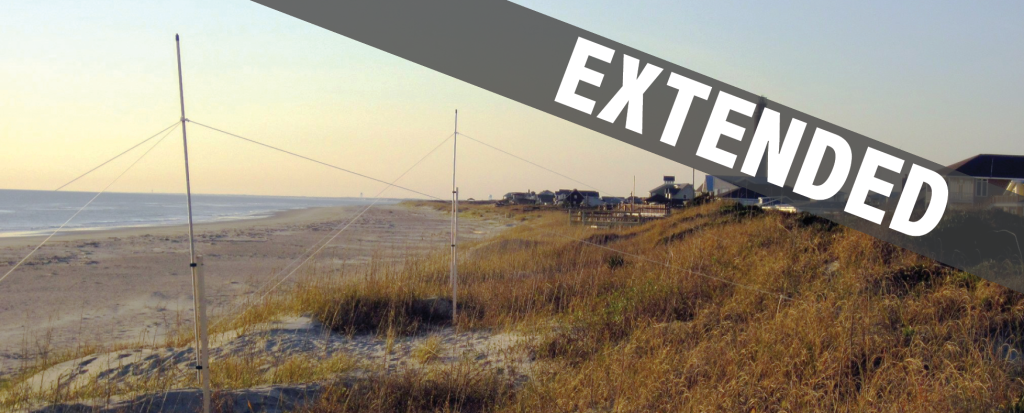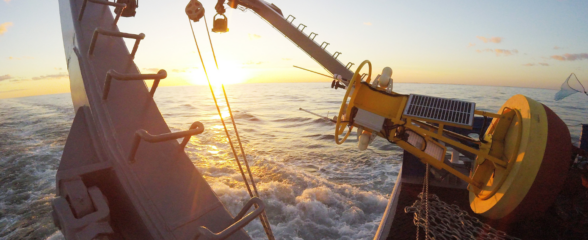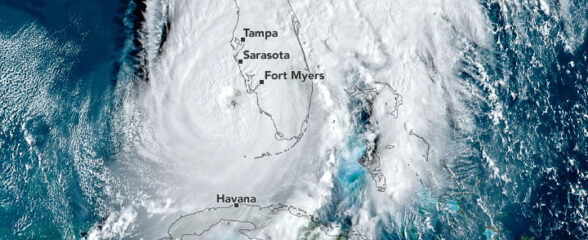
A competition to turn high frequency radar data into a tool or product that tackles real-world questions and curiosities.
Overview
High frequency radars (HF radar) are land-based systems that measure the speed and direction of ocean surface currents in near real-time. HF radar data are used to track oil or other hazardous materials (such as harmful algal blooms) and assist in search and rescue missions at sea.
The Southeast Coastal Ocean Observing Regional Association (SECOORA) is one of the 11 Integrated Ocean Observing System regional partners. IOOS supports HF radar operations in all US coastal regions. SECOORA operates a network of 16 HF radars in the Southeast.
SECOORA is asking students and early career professionals to explain the importance of HF radar and create tools that use archived SECOORA HF radar data. There are two $3500 prizes. Proposals are due May 15, 2020 (extended).
Click here for a PDF of the Data Challenge.
Goals of the Data Challenge
- Encourage the use of data resources available from SECOORA (secoora.org).
- Use technologies, tools, videos, and creativity to visualize, analyze, and apply HF radar data in order to tackle real-world problems/curiosities.
- Build on and enhance existing SECOORA initiatives.
- Provide students and young professionals with the opportunity to develop a competitive proposal.
About the Dataset
SECOORA supports 16 HF radar in the southeastern U.S. Each system deployed along the coast uses radar technology to map ocean surface currents in near real-time. Scientists can determine the speed and direction of currents in multiple areas and generate maps of the ocean surface currents using arrows to show the current direction.
Data challenge contestants are required to use the archived SECOORA HF radar radial dataset in their project. Data access information can be found on the SECOORA HF radar website.
All applicants are encouraged to visit the following links to learn more about HF radar:
- Click here to watch a video from US IOOS outlining how HF radar provides detailed information in real-time on coastal ocean surface currents.
- Visit the US IOOS HF radar webpage.
- HF Radar Network provides reliable data telemetry, archiving, and integrated processing.
- A Plan to Meet the Nation’s Needs for Surface Current Mapping presents the uses of HF radar and requirements that drive the measurement of ocean surface currents.
- Code packages for management, analyses and/or quality control of HF Radar data:
- Example Jupyter Notebooks accessing and using the SECOORA HF Radar radial data
Ideas
There are many uses of HF radar data. Below are some examples to get you started:
- Consolidation, documentation and improvements of existing QARTOD quality control routines and algorithms in the ioos_qc quality control library.
- Development of standard algorithms and routines to generate Total Vector products from overlapping radial data/files.
- Techniques for visualizing a site’s radial data over time, i.e. status, coverage area, coverage area %.
- Novel scientific use of the radial data (gulf stream detection, tidal/harmonic
analysis, particle trajectory, etc.).
Prizes
SECOORA is offering two prizes in two different categories. Applicants can work as an individual or in teams. If working as a team, all members must meet the eligibility requirements.
Category 1: Undergraduate
Prize: $3,500
Eligibility
Applicants must 1) reside in and attend an academic institution in the United States, 2) be an undergraduate student, 3) the individual or team must have an advisor/mentor from the institution they attend, 4) must be enrolled as an undergraduate student during the Spring 2020 semester, and 5) propose a project that incorporates data from the HF radar datasets available in the SECOORA region from here.
Category 2: Other
Prize: $3,500
Eligibility
Applicants must 1) reside in the United States, 2) be a graduate student OR an early career professional (working less than five years from your most recent graduation date), 3) the individual or team must have an advisor/mentor, and 4) propose a project that incorporates data from the HF radar datasets available in the SECOORA region from here.
How to Apply
Each applicant or team must submit their proposal by 5:00 PM ET, May 15, 2020 (extended). All proposals will be evaluated based on the review criteria and if chosen as the winning project, the successful applicant will have until January 31, 2021 to complete the project. All winning projects will be featured on secoora.org. Proposals can only be submitted in one category.
Proposal Format
All proposals must follow the below required format. Proposals that do not follow the required format will not be evaluated.
Maximum page length is 5 pages (does not include appendices). Text should be 12-point font, all margins 1-inch and must include the following components:
- Title Page (Proposal Cover Sheet) is limited to 1 page and must include:
- Proposal title
- Category under which you are applying: Category 1: Undergraduate or Category 2: Other
- Lead applicant’s name and complete contact information
- Team members, if any, and complete contact information
- Advisor name and contact information (i.e. professor supervising work)
- Project summary (1 paragraph)
- Project Description is limited to 4 pages and must include:
- Statement of the issue to be addressed
- Description of the product or tool that will be developed
- Statement of how the project will directly benefit specific users or stakeholders (please list all partners if there are any)
- Goals, objectives and anticipated results
- Methodology or approach, including:
- Explanation of the technical approach
- Data analysis and/or visualization techniques that will be employed
- Describe project deliverables and how results will be shared with users/stakeholders. Upon completion of the project you will need to:
- Provide a brief report on how the data was used for the project.
- Produce a short video on the project, and its value to you and potential users.
The following appendices are required; however, they do not count towards the page limit.
Appendix 1: Project timeline that lists the project objectives and when you plan to complete each objective and submit your final results to SECOORA (note the project must be completed by January 31, 2021). (1-page maximum)
Appendix 2: For undergraduate and graduate students, a signed letter of support from their major professor is required stating you are a student in good standing. For early career professionals, a letter of support from their hiring manager/supervisor is required.
Appendix 3: One-page resume or curriculum vitae (CV). If working in a team, please provide the one-page resume or CV of all team members.
Submit Your Proposal
Please submit the entire application package electronically in PDF format no later than 5:00 PM ET on May 15, 2020 (extended) to Abbey Wakely (abbey@secooraorgpact.wpengine.com) and cc Jennifer Dorton (jdorton@secooraorgpact.wpengine.com).
Evaluation Criteria
Evaluation criteria are the same for ALL categories.
- Creativity and Innovation – 25%
- Demonstrated Value to a Stakeholder – 25%
- Technology/Scientific Merit – 20%
- Methodology – 20%
- Follows Proposal Guidelines – 10%
Timeline
May 15, 2020 (extended): All proposals are due via email to Abbey Wakely (abbey@secooraorgpact.wpengine.com) and a cc Jennifer Dorton (jdorton@secooraorgpact.wpengine.com). Type SECOORA Data Challenge Proposal into the email subject line.
May – June 2020: Proposal review period. Applicants may be contacted and asked to discuss their project with judges on a webinar.
June 2020: Winners are notified.
January 31, 2021: Full projects are completed. Final product deliverables are submitted to SECOORA and include the product/application and all appropriate documentation. The use of open source software is encouraged, and all final products should allow for unrestricted distribution on the SECOORA website.
Questions?
Questions regarding proposal submission may be submitted to abbey@secooraorgpact.wpengine.com. Good-faith efforts will be made to answer as many questions as possible, but an answer is not guaranteed for every question.
Award Disbursement Information
Winners will receive half of the award ($1,750) by July 2020. Upon completion of the project, winners will need to provide a brief report and video on the project, and the value/impact of the work. Once deliverables are approved, winners will receive the remaining portion ($1,750) of the award. Award winners will be responsible for all tax liabilities associated with the winnings and a 1099 will be disbursed by SECOORA by February 1, 2021.
This is an open and competitive process. SECOORA reserves the right to reject any and all applications/proposals received as a result of this process. SECOORA reserves the right to request that applicants make modifications to proposals at any time before an award is made.
Related news

Funding Cuts to NOAA IOOS Will Hurt the Southeast
Proposed federal funding cuts would eliminate the IOOS Regional Observations budget for next year. Contrary to the budget Congress has already approved for this year, the Executive Branch wants these proposed cuts to go into effect in 2025.

SECOORA Webinar on the Rapid Intensification of Hurricane Ian: Warm Subsurface Water on the Wide Continental Shelf
Join us Thursday, April 24th at 12 PM ET for the April installment of the SECOORA Coastal Observing in Your Community Webinar Series! This month, we will hear from Dr. Yonggang Liu from the University of South Florida. He will discuss his research on the rapid intensification of Hurricane Ian in relation to anomalously warm subsurface water on the wide...

Webinar: SECOORA Data Portal Demo
Join us on Thursday, February 20, 2025 at 1:00 PM ET to learn more about the SECOORA Data Portal and how to navigate it. Axiom Data Science will be providing an overview of the portal, including how to search the Catalog and make a custom data view.